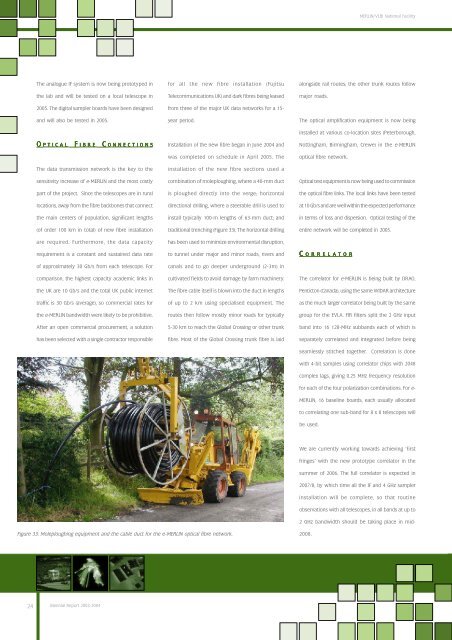Biennial Report 2003-2004 - Merlin
Biennial Report 2003-2004 - Merlin
Biennial Report 2003-2004 - Merlin
Create successful ePaper yourself
Turn your PDF publications into a flip-book with our unique Google optimized e-Paper software.
24<br />
The analogue IF system is now being prototyped in<br />
the lab and will be tested on a local telescope in<br />
2005. The digital sampler boards have been designed<br />
and will also be tested in 2005.<br />
F<br />
O PTICAL PTICAL F IBRE IBRE C ONNECTIONS<br />
ONNECTIONS<br />
ONNECTIONS<br />
<strong>Biennial</strong> <strong>Report</strong> <strong>2003</strong>-<strong>2004</strong><br />
C<br />
The data transmission network is the key to the<br />
sensitivity increase of e-MERLIN and the most costly<br />
part of the project. Since the telescopes are in rural<br />
locations, away from the fibre backbones that connect<br />
the main centers of population, significant lengths<br />
(of order 100 km in total) of new fibre installation<br />
are required. Furthermore, the data capacity<br />
requirement is a constant and sustained data rate<br />
of approximately 30 Gb/s from each telescope. For<br />
comparison, the highest capacity academic links in<br />
the UK are 10 Gb/s and the total UK public internet<br />
traffic is 30 Gb/s (average), so commercial rates for<br />
the e-MERLIN bandwidth were likely to be prohibitive.<br />
After an open commercial procurement, a solution<br />
has been selected with a single contractor responsible<br />
for all the new fibre installation (Fujitsu<br />
Telecommunications UK) and dark fibres being leased<br />
from three of the major UK data networks for a 15-<br />
year period.<br />
Installation of the new fibre began in June <strong>2004</strong> and<br />
was completed on schedule in April 2005. The<br />
installation of the new fibre sections used a<br />
combination of moleploughing, where a 40-mm duct<br />
is ploughed directly into the verge; horizontal<br />
directional drilling, where a steerable drill is used to<br />
install typically 100-m lengths of 63-mm duct; and<br />
traditional trenching (Figure 33). The horizontal drilling<br />
has been used to minimize environmental disruption,<br />
to tunnel under major and minor roads, rivers and<br />
canals and to go deeper underground (2-3m) in<br />
cultivated fields to avoid damage by farm machinery.<br />
The fibre cable itself is blown into the duct in lengths<br />
of up to 2 km using specialised equipment. The<br />
routes then follow mostly minor roads for typically<br />
5-30 km to reach the Global Crossing or other trunk<br />
fibre. Most of the Global Crossing trunk fibre is laid<br />
Figure 33: Moleploughing equipment and the cable duct for the e-MERLIN optical fibre network.<br />
MERLIN/VLBI National Facility<br />
alongside rail routes; the other trunk routes follow<br />
major roads.<br />
The optical amplification equipment is now being<br />
installed at various co-location sites (Peterborough,<br />
Nottingham, Birmingham, Crewe) in the e-MERLIN<br />
optical fibre network.<br />
Optical test equipment is now being used to commission<br />
the optical fibre links. The local links have been tested<br />
at 10 Gb/s and are well within the expected performance<br />
in terms of loss and dispersion. Optical testing of the<br />
entire network will be completed in 2005.<br />
C ORREL ORRELA ORREL T OR<br />
OR<br />
The correlator for e-MERLIN is being built by DRAO,<br />
Penticton (Canada), using the same WIDAR architecture<br />
as the much larger correlator being built by the same<br />
group for the EVLA. FIR filters split the 2 GHz input<br />
band into 16 128-MHz subbands each of which is<br />
separately correlated and integrated before being<br />
seamlessly stitched together. Correlation is done<br />
with 4-bit samples using correlator chips with 2048<br />
complex lags, giving 0.25 MHz frequency resolution<br />
for each of the four polarization combinations. For e-<br />
MERLIN, 16 baseline boards, each usually allocated<br />
to correlating one sub-band for 8 x 8 telescopes will<br />
be used.<br />
We are currently working towards achieving ‘first<br />
fringes’ with the new prototype correlator in the<br />
summer of 2006. The full correlator is expected in<br />
2007/8, by which time all the IF and 4 GHz sampler<br />
installation will be complete, so that routine<br />
observations with all telescopes, in all bands at up to<br />
2 GHz bandwidth should be taking place in mid-<br />
2008.


